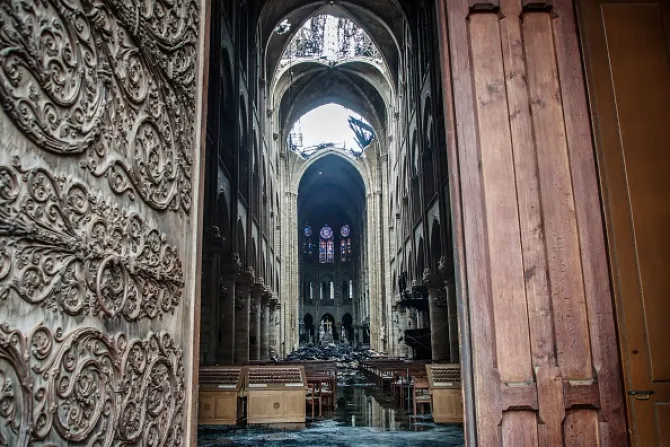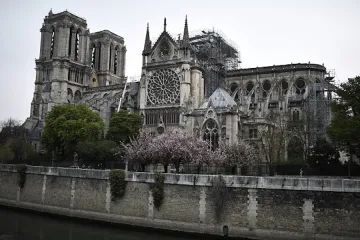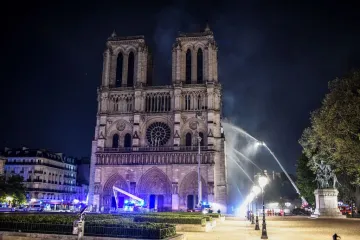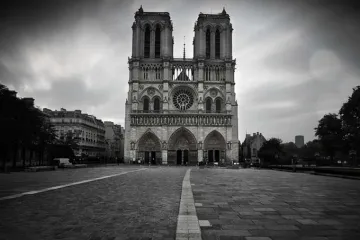Paris, France, Apr 16, 2019 / 11:00 am
Father Pierre Amar was praying in Notre-Dame de Paris at 5 p.m. Monday evening to prepare spiritually for the Easter Triduum; hours later he was ringing the "funeral bells" at his parish to mourn the flames consuming the "mother of all the cathedrals in France."
Hearing the bells, Amar's parishioners came to their church in Versailles, to pray the rosary together as Notre-Dame burned.
"The Cathedral of Notre-Dame has a particular place in our hearts and in our history," Father Amar told CNA April 16. "It is hard to find my words because the emotion is so great."
"This morning at Mass, we prayed to the Blessed Virgin Mary ... 'Mary, dry our tears'," he said. "We are so sad; France is mourning its cathedral."
Father Joseph Koczera was having dinner in Paris with fellow priests when he heard the news.
"We were all in shock," he said. "We all felt a sense of despair, seeing images of the cathedral in flames and fearing that it would be completely destroyed."
"I walked down to the Île de la Cité to join the many Parisians who were there watching the cathedral burn. What struck me when I arrived was the atmosphere of prayer and reflection: many were singing the Ave Maria in French, and many were kneeling in prayer," Koczera, an American priest based in Paris, told CNA.
"Some were crying, but there was a palpable sense of Christian hope, a sense that this beloved church would be saved and would experience a kind of physical resurrection," he said.
While greatly damaged, the main structure of Notre-Dame, including much of its interior vaulted ceiling remained intact as firefighters worked late into the night to put out the flames.
Father Pierre-Hervé Grosjean of the Diocese of Versailles shared a photo on Twitter April 16 revealing the extent of the damage to the main altar.
"Inside Notre-Dame de Paris, in the midst of rubble, the cross is there. Standing. It seems intact. Painful and luminous at the same time. Victorious over evil. Not far, Mary is there, her statue is always a witness. This image is worth all the homilies," Grosjean reflected in French.
À l'intérieur de Notre-Dame de Paris, au cœur des décombres et des gravas, la Croix est là. Debout. Elle semble intacte. Douloureuse et lumineuse à la fois. Victorieuse du mal. Pas loin, Marie est là,sa statue en témoigne toujours
- Abbé Grosjean ن (@abbegrosjean) April 16, 2019
Cette photo vaut toutes les homélies. #NotreDame pic.twitter.com/WkhGfpDD94
Father Franck Derville, a Parisian priest, wrote on Twitter, "140 years ago (April 16, 1879) died St. Bernadette of Lourdes, to whom the Virgin - #NotreDame - said: 'I do not promise to make you happy in this world, but in the other.'"
Il y a 140 ans (16 avril 1879) mourrait sainte Bernadette de Lourdes, à qui la Vierge - #NotreDame - avait dit : "je ne vous promets pas de vous rendre heureuse en ce monde, mais dans l'autre." #Espérance.
- Franck Derville ن (@pfranckyd) April 16, 2019
(Story continues below)
Originally built between the twelfth through fourteenth centuries, the landmark cathedral in the French capital is one of the most recognizable churches in the world, receiving more than 12 million visitors each year.
"I think it's difficult to sum up the importance of Notre-Dame de Paris in just a few words. It's not just a tourist attraction; it's a place of prayer, where ordinary people from all walks of life go each day for Mass or confession or simply to pray privately," Father Koczera explained.
Father Amar summed up its importance, "I can say that Notre-Dame is France, and France is Notre-Dame."
"The Cathedral of Paris is the witness of our history, not only the history of the Catholic Church in France, but the history of France," Amar continued.
"For example, at the liberation of Paris in 1944 when the Americans came with the French army in Paris in August 1944, we had the Magnificat sung in the Cathedral of Paris," he said.
"Notre-Dame is, in a way, the summit of Christendom or at least it symbolizes the 12th century -- the century of cathedrals, the century of St. Thomas Aquinas. In a way I think this event, and I pray for this, should help us to become more aware of our Christen heritage and to realize that we all need conversion," Father Carlos Hamel told CNA.
Father Hamel, who has lived in France for the past nine years, said that he is praying for this tragedy to "reawaken" the faith in France.
"I wouldn't be surprised, really, that this happening just before the Triduum will cause more people coming to Mass next weekend," Hamel said.
The Archdiocese of Paris announced April 16 that all of the Holy Week liturgies scheduled to occur Notre-Dame this week will occur in Saint Sulpice, the second largest church in Paris.
Saint Sulpice was also damaged by fire one month ago, a fire that the Vienna-based Observatory on Intolerance and Discrimination Against Christians in Europe reported was started deliberately on its large wooden door.
Each of the priests commented that the Notre-Dame fire has encouraged a greater sense of unity throughout the country.
"Notre-Dame de Paris remains a potent national symbol for many French people, whether they are religious believers or not. It is telling that, in the hours after the fire started, political leaders and public figures from left to right and across the ideological spectrum were unanimous in declaring that the cathedral should be rebuilt and that no expense should be spared to make that happen," Father Koczera commented.
"It seems that Notre-Dame de Paris remains a symbol that the people of France can unite around, regardless of their personal beliefs," he added.
Father Amar that the event caused fellow countrymen to "discover our unity and human fraternity" at a time when the "climate in France is not so peaceful."
The French priest said that as he walked along streets in the local Church in his collar Tuesday, many strangers approached him and said things like, "Father, we are with you," and "I am not Catholic, but we are so touched for you, for France."
"It gave me a lot of joy," Amar reflected. "We lost an edifice, but we have discovered, this morning, the unity of our country."
"Notre-Dame. It means 'Our Lady,' not 'The Lady of France.' Our Lady is for everybody – Christian people, believers, non-believers -- everyone is welcome in the heart of Notre-Dame," Amar said.
Editor's note: An earlier version of this article identified Fr. Grosjean as a priest of the Archdiocese of Paris, rather than the Diocese of Versailles.






